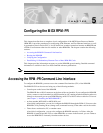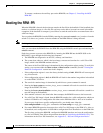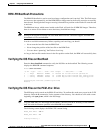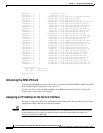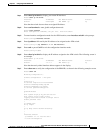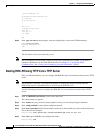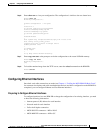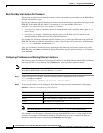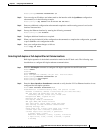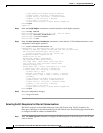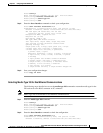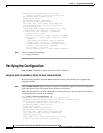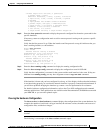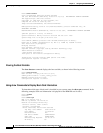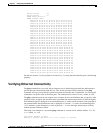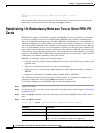
5-2
Cisco MGX Route Processor Module (RPM-PR) Installation and Configuration Guide
Release 2.1, Part Number 78-12510-02 Rev. C1, August 31, 2004
Chapter 5 Configuring the MGX RPM-PR
Booting the RPM-PR
To connect a modem to the auxiliary port on the RPM-PR, see Chapter 3, “Installing the MGX
RPM-PR.”
Booting the RPM-PR
When the RPM-PR is booted, the boot image must be the first file in the bootflash. If the bootflash does
not have a valid boot image as a first file, the card may not be able to boot and can result in bootflash
corruption. If the bootflash is corrupted, you will have to send the card back for an external burn with a
valid boot image.
You can reboot the RPM-PR from the PXM by entering the command resetcd <card_number> from the
switch CLI, where card_number is the slot number of the RPM-PR that is being rebooted.
Note Omitting the card number resets the entire system.
Also, you can reboot the RPM-PR from the RPM-PR using the RPM-PR console port and entering the
reload command.
Each time you turn on power to the RPM-PR, by inserting the RPM-PR into the MGX 8850 or the
MGX 8950, it goes through the following boot sequence:
1. The RPM-PR runs diagnostics on the CPU, memory, and interfaces.
2. The system boot software, which is the boot image, executes and searches for a valid Cisco IOS
image, which is the RPM-PR runtime software.
The source of the Cisco IOS image is determined by the configuration register setting. To verify this
setting, you can enter either the show version or show bootvar command. (See the “Viewing the
Hardware Configuration” section later in this chapter.)
• If the configuration register is set to the factory-default setting of 0x01, RPM-PR will come up and
stay in boot mode.
• If the configuration register is 0x2, the RPM-PR will look for the runtime image either in bootflash
or on the PXM C:FW drive.
3. The search for runtime image is determined by which boot system command is entered.
• Entering the boot system x:<runtime_image_name> command will result in a search for a runtime
image on the PXM C:FW drive.
• Entering the boot system bootflash:<runtime_image_name> command will result in a search for a
run time image in the bootflash.
4. If the runtime software is not found after three attempts, the RPM-PR reverts to the boot mode.
5. If a valid Cisco IOS image is found, then the RPM-PR searches for a valid configuration, which can
reside in NVRAM or as a configuration file either on the PXM hard disk x: drive or in bootflash.
If you want to load from a specific configuration file, you should enter either the
boot config bootflash:<config_file> command or the boot config x:<config_file> command.
6. For normal RPM-PR operation, there must be a valid Cisco IOS image on the PXM-45 x: drive or
in bootflash, and a configuration in NVRAM or configuration file in bootflash or on the PXM disk.
The first time you boot the RPM-PR, configure the RPM-PR interfaces and save the configuration
to a file in NVRAM. Then follow the procedure described in “Initializing the RPM-PR Card.” For
information on the Cisco IOS instructions, see Appendix C, “IOS and Configuration Basics.”



